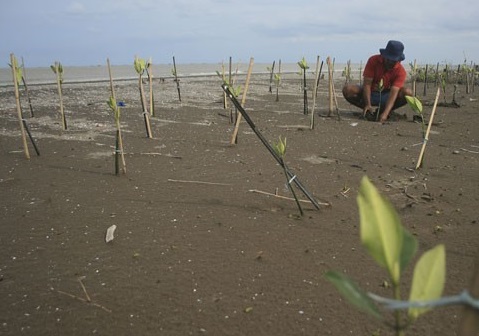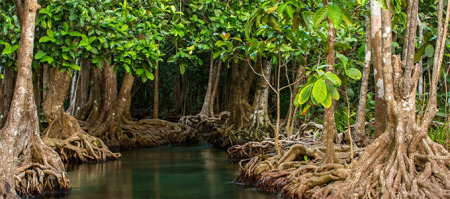The economic and social benefits of mangroves are estimated to run into the hundreds of billions of dollars worldwide. Sadly, the lack of carbon finance mechanisms has meant mangroves are not seen as a resource.
Lima, December 9, 2014 - The economic and social benefits of mangroves - which are estimated to run into the hundreds of billions worldwide - remain largely untapped due to a lack of carbon finance mechanisms, appropriate policy interventions, and rapid mangrove deforestation, according to a new United Nations Environment Programme (UNEP) report launched on December 9 at the 20th Conference of the Parties on Climate Change.
The Guiding Principles for Delivering Coastal Wetland Carbon Projects finds that the potential economic, social and environmental gains from conserving mangroves - 90 per cent of which are found in developing countries and many of which are under threat - including from mangrove inclusion in Reducing Emissions from Deforestations and forest Degradation (REDD+) strategies and protecting and enhancing mangrove stores of carbon, still remain largely under-exploited.
UNEP estimates the economic cost of the destruction of carbon-rich mangroves, which are being cleared 3 - 5 times faster than terrestrial forests, at $42 billion in economic damages annually.
 Some mangrove areas in SE Asia are seeing replanting by local people who appreciate the value of the mangrove ecosystemThe report argues that while policymakers and financial markets are beginning to take action, more needs to be done to develop new methodologies for carbon accounting for mangroves and other coastal wetland ecosystems, to conserve mangroves, and to increase the profile of mangroves in REDD+ and the United Nations Framework Convention on Climate Change (UNFCCC).
Some mangrove areas in SE Asia are seeing replanting by local people who appreciate the value of the mangrove ecosystemThe report argues that while policymakers and financial markets are beginning to take action, more needs to be done to develop new methodologies for carbon accounting for mangroves and other coastal wetland ecosystems, to conserve mangroves, and to increase the profile of mangroves in REDD+ and the United Nations Framework Convention on Climate Change (UNFCCC).
A number of coastal wetlands carbon project initiatives - which include mangroves - in their infancy in many parts of the world, including Kenya, Senegal, West Bengal, and Sumatra are already showing indications of success.
However, according to a report from UNEP, Carbon Pools and Multiple Benefits of Mangroves in Central Africa Assessment for REDD+, many countries will be unable to access carbon incentives, improved governance, jobs, and a range of other benefits under the global REDD+ programme unless they include mangroves in their national definition of forests.
Pristine resource
The report finds that the mangroves of Central Africa which are found in Cameroon, Gabon, the Republic of the Congo, Equatorial Guinea, Sao Tome and Principe, the Democratic Republic of the Congo, and Angola, could be amongst the most carbon-rich ecosystems in the world, with an estimated release of 1,299 tonnes of C02 per hectare of cleared pristine mangrove.
Unfortunately between 2000 and 2010 it is estimated that over 100 million tonnes of C02 was released into the atmosphere with the clearing and degrading of 771.07km2 of mangroves in Central Africa, which not only represents a potentially significant economic loss in terms of uncapitalized carbon values, but has many other direct economic and social costs.
The economic costs at the time of the research include US$ 11,286 per hectare in seawall replacement, and US$ 7,142 per hectare in benefits for protection of rural infrastructure against shoreline erosion (US$151,948 per hectare for urban mangroves).
The social costs moreover are even greater for the region. As calculated by the Interagency Working Group on Social Cost of Carbon, for the year 2015, the lower end estimate of the social cost of carbon is likely to be US$ 15,588 per hectare, with the higher estimates coming in at US$ 151,983 per hectare.
While these are not values that can be capitalized upon in a marketplace, they are values that are relevant to the global economy, and especially for local communities.
New technology
Fortunately, as efforts to conserve and restore mangroves receive greater attention worldwide, new satellite technology has been tested and proven effective in the monitoring of mangrove restoration. In a study conducted by UNEP, Monitoring the Restoration of Mangrove Ecosystems from Space, around 70 per cent of project sites assessed showed positive restoration results, preventing the release of significant emissions of C02 into the atmosphere.
Combined with on the ground surveys, the satellite remote sensing technology could help policy makers monitor, evaluate, and where necessary take corrective action to ensure the restoration and conservation of mangroves worldwide.
 UNEP estimates the economic cost of the destruction of carbon-rich mangroves, which are being cleared 3 – 5 times faster than terrestrial forests, at $42 billion in economic damages annually. Key Report Takeaways
UNEP estimates the economic cost of the destruction of carbon-rich mangroves, which are being cleared 3 – 5 times faster than terrestrial forests, at $42 billion in economic damages annually. Key Report Takeaways
Guiding Principles for Delivering Coastal Wetland Carbon Projects
- Coastal wetlands policy and management interventions can be deployed in all coastal settings to improve reductions in Greenhouse Gas (GHG) emissions and removals.
- Mangroves and temperate tidal forests can be the focus of REDD+ actions, depending upon national definition of forest.
The consequences of sea-level rise need to be recognized and accounted for when planning and enacting coastal wetlands carbon interventions, says the report, adding that conservation of existing intact coastal wetlands carbon ecosystems is technically the simplest and most effective mechanism to manage carbon stocks, and provides the greatest ecosystem benefits.
It also says that there are only limited examples of coastal wetlands carbon ecosystem restoration interventions that account fully for GHG and access carbon markets for finance. Additionally, the technical ability to successfully restore coastal wetland ecosystems today is available on a global level, even if it is not always applied.
To achieve a successful intervention, coastal wetland conservation or restoration should be planned with a landscape response to climate change in mind, say the authors. Project success is greatly increased if local community engagement and capacity building predates or accompanies the intervention - as proven by several examples of good practice that have been implemented.
Key Report Takeaways
Carbon Pools and Multiple Benefits of Mangroves in Central Africa - Assessment for REDD+
- Explore the potential for including mangroves in the national definition of forests for each of the countries in the region, in order for this ecosystem to be eligible for inclusion in national REDD+ strategies.
- Include mangrove regions and pilot projects in national REDD+ strategies.
- Understand and analyze mangrove-specific drivers of deforestation.
- Develop national priorities for mangrove action in the region through a stakeholder engagementprocess with governments, private sector, civil society, and local communities.
- National priorities can provide the basis for decisions on activities to support through REDD+ strategies.
- Implement the newly-developed Intergovernmental Panel on Climate Change GHG Inventory guidelines on wetlands in order to include mangroves in national Greenhouse Gas Inventories and National Communications to the UNFCCC.
Read the rest of the article here.